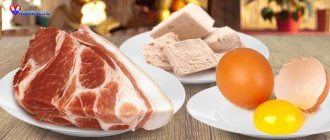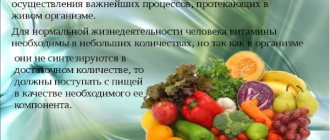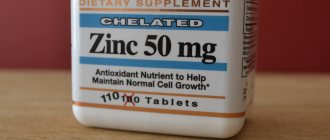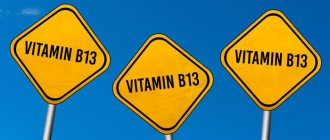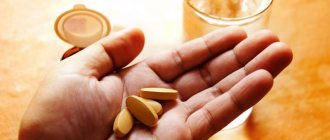At the everyday level, we all know about the importance of vitamins for the body, and that their deficiency negatively affects health. True vitamin deficiency - a lack of vitamins is rare in the modern world: if you eat a balanced diet, then even with a simple diet without frills, a modern person will not experience vitamin deficiency.
However, more and more people are complaining of poor health, insomnia, fatigue, while doctors are unable to make any clear diagnosis. Modern scientific research has proven that the content of vitamins in the diet has decreased by a third over the last decade. Industrial processing of foods and poor ecology have led to a decrease in vitamins in food. As a result, despite the most exquisite and, at first glance, balanced menu, we experience a chronic deficiency of vitamins.
Ascorbic acid (vitamin C)[edit | edit code]
Vitamin C content in some foods
Ascorbic acid
(vitamin C) - an organic compound related to glucose, is one of the essential nutrients in the human diet, which is necessary for the normal functioning of connective and bone tissue. Performs the biological functions of a reducing agent and coenzyme of some metabolic processes, and is considered as an antioxidant.
Ascorbic acid in products.
Significant amounts of ascorbic acid are contained in currants, rowan berries, rose hips, as well as many vegetables and fruits; there is little of it in citrus fruits.
Effects of ascorbic acid[edit | edit code]
Formation of collagen, serotonin from tryptophan, formation of catecholamines, synthesis of corticosteroids. Ascorbic acid is also involved in the conversion of cholesterol to bile acids. Vitamin C is necessary for detoxification in hepatocytes with the participation of cytochrome P450. Restores ubiquinone and vitamin E. Stimulates the synthesis of interferon, therefore, participates in immunomodulation. Converts ferric iron obtained from plant products into divalent iron, thereby promoting its absorption.
Inhibits the glycosylation of hemoglobin, inhibits the conversion of glucose to sorbitol. Vitamin C is a powerful antioxidant that protects lipoproteins from oxidation and is an antiatherogenic molecule.
According to the results of a 2014 study published in the journal Allergy. Asthma & Clinical Immunology,” vitamin C intake helps reduce the severity of bronchospasm and respiratory symptoms (cough, wheezing, shortness of breath, shortness of breath) induced by exercise.[1] Exercise-induced bronchospasm is a transient narrowing of the bronchial lumen that occurs during or after exercise.
Vitamin C content in some foods
| Product | Vitamin C content, mg/100 g of product |
| Dry rosehip | 1000 |
| Sweet red pepper | 250 |
| Black currant | 200 |
| Sea buckthorn | 200 |
| Rowan | 160 |
| Parsley (greens) | 150 |
| Sweet green pepper | 130 |
| Needles | 130 |
| Cranberry | 100 |
| Dill | 100 |
| Oranges | 60 |
| Garden strawberries | 60 |
| Cabbage | 45 |
| Lemons | 40 |
| Beef liver | 33 |
| Fresh potatoes | 25 |
| Tomatoes | 20 |
| Apple | 20 |
| Milk | 2 |
Vitamin C for athletes
Vitamin C is the most important stimulator of anabolic processes in the body. It enhances protein absorption, thereby promoting muscle gain. The presence of ascorbic acid largely determines the degree of protein absorption by the body, which is used by athletes to build muscle mass.
Vitamin C is necessary to compensate for oxidative stress that forms during physical activity. The strong antioxidant effect of ascorbic acid helps protect the body of athletes during overload.
Vitamin C has a significant effect on the hormonal system and is involved in the production of steroid hormones, including testosterone, which is responsible for high athletic performance.
Ascorbic acid prevents the production of your own cortisol, a stress-catabolic hormone that reduces the rate of muscle growth. Bodybuilders take ascorbic acid during drying to achieve maximum relief.
These are not all the reasons why ascorbic acid is of great importance for those who play sports professionally. Vitamin C is involved in the production of collagen and accelerates tissue regeneration. Collagen is a building material for connective tissue. During training, the load on muscles and tissues increases, often to critical conditions that provoke sports injuries.
Athletes' bodies need increased collagen production to protect themselves from injury. Enhanced collagen production reduces the likelihood of injury, and in the event of injury, it promotes faster tissue repair.
Vitamin C reduces the likelihood of bronchospasm, which athletes are susceptible to during training. A decrease in the clearance in the bronchi is caused by great physical exertion; athletes feel this as a lack of air or cough. Taking ascorbic acid before training reduces the risk of bronchospasms, improves the quality of training and the athlete’s well-being.
Vitamin C is involved in the production of interferon, thereby stimulating the immune system and increasing the body's defenses. Athletes are no less, and sometimes even more susceptible to colds and other inflammatory processes.
The effect of vitamin C on the nervous system and mental state has been proven. Vitamin C is a powerful antidepressant, as it stimulates the production of serotonin, the so-called happiness hormone. Taking vitamin C helps athletes cope with the physical and mental stress that often accompanies preparation for sports competitions.
Ascorbic acid in bodybuilding[edit | edit code]
The absorption of dietary protein and the further synthesis of new protein structures, in particular in muscles, depend on vitamin C. Vitamin C is the strongest stimulator of muscle anabolism. However, you should take it wisely for bodybuilding and not exceed the dosage.
In addition, studies have found that ascorbic acid has an anti-catabolic effect by suppressing the secretion of cortisol[2][3][4] and the process of peroxidation, which has a destructive effect on muscles.[5] Therefore, vitamin C can be taken before training to reduce catabolic processes and protect muscles, and also after completing an anabolic steroid cycle, as a component of PCT. Some authors report the ability to increase testosterone production, but studies refute this.[6]
Muscle growth[edit | edit code]
In 2020, Norwegian scientists evaluated[7] the effects of taking vitamin C (500 mg) and vitamin E (117.5 mg) before and after exercise for 12 weeks on muscle growth and strength in older adults (60-81 years). Strength training took place 3 times a week, for all muscle groups. On rest days, supplements were taken in the same doses in the morning and evening. As a result, it turned out that the subjects who took these antioxidants had a lower increase in muscle mass, but no differences in the increase in strength were recorded. Scientists suggest that oxidative stress caused by exercise may be a significant contributor to muscle hypertrophy.
However, in an earlier study from 2008, another group of Canadian scientists found that vitamin C (1000 mg/day) and vitamin E (600 mg/day) caused greater gains in lean muscle mass in older adults compared to subjects. , who performed only training.[8]
Doses and regimen[edit | edit code]
The physiological need for adults is 90 mg/day, for bodybuilding 100-150 mg/day. For colds, as well as after a course of anabolic steroids to block cortisol, the dose is increased to 1000-2000 mg per day. Maximum dose 3000 mg.
Nature of the substance
Vitamin C is an organic component.
It belongs to the most important compounds required for the body to function properly. It must be used daily. It is part of the group of vitamins that can be dissolved in water, so even the largest doses do not pose any danger to your health.
Among the properties, one of the most irreplaceable is its participation in metabolic processes.
Regarding metabolism, the blog has special articles on this topic that you can also study. The material is very important! I recommend this and this article to you.
It also helps support the activity of bone and connective tissue. It has been noted that ascorbic acid has many characteristics in common with glucose.
The benefits of ascorbic acid salts[edit | edit code]
Source:
“Basics of individual and collective nutrition for athletes”
.
Author:
professor, doctor of medical sciences, S.A.
Polievsky Publishing house.
: Physical education and sports, 2005
Ascorbic acid is useful in all respects, except for one thing: like every acid, it destroys teeth, irritates the gastric mucosa, resulting in heartburn. We are talking about large quantities of ascorbic acid - all over the world it has long been prescribed in grams, not milligrams. Since the generally accepted dosages of ascorbic acid in the world are constantly increasing, there is a need for new drugs that do not have negative consequences.
These are mainly sodium ascorbate and calcium ascorbate - salts of ascorbic acid, which have a neutral reaction. Bifftered C-1500 is just calcium ascorbate. It differs from ascorbic acid only in that it contains calcium and has no taste. You can prepare ascorbic acid salts yourself. To obtain sodium ascorbate, ascorbic acid is mixed with ordinary baking soda (in solution) or with calcium chloride.
Risks of Taking Vitamin C
Vitamin C can cause a number of unpleasant effects, given its acidic nature. Ascorbic acid in its pure form destroys tooth enamel, so after eating berries and fruits with a high content of ascorbic acid, you must at least rinse your mouth. Ascorbic acid has an irritating effect on the mucous membrane of the stomach and duodenum, often causing heartburn. But such negative phenomena threaten if the dose of the vitamin is calculated not in milligrams, but in grams.
Since the need for ascorbic acid among athletes is high, pharmaceutical companies produce ascorbic acid preparations in the form of salts. Typically these are sodium ascorbate and calcium ascorbate. Salts do not irritate the mucous membranes and provide the body with vitamin C.
Berestova Svetlana for women's magazine InFlora.ru
When using or reprinting material, an active link to the women's online magazine InFlora.ru is required
Links[edit | edit code]
- https://www.sciencedaily.com/releases/2014/12/141208074317.htm
- "International Journal of Sports Medicine": Vitamin C Supplementation Attenuates the Increases in Circulating Cortisol, Adrenaline and Anti-Inflammatory Polypeptides Following Ultramarathon Running, Peters EM, Anderson R, Nieman DC, Fickl H, Jogessar V. October 2001
- Effects of Ascorbic Acid on Serum Cortisol and the Testosterone: Cortisol Ratio in Junior Elite Weightlifters Marsit, Joseph L.; Conley, Michael S.; Stone, Michael H.; Fleck, Steven J.; Kearney, Jay T.; Schirmer, Ginger P.; Keith, Robert L.; Kraemer, William J.; Johnson, Robert L.
- https://www.charlespoliquin.com/Blog/tabid/130/EntryId/1562/Tip-435-Take-Vitamin-C-Post-Workout-To-Lower-Cortisol-Recover-Faster.aspx
- Effect of vitamin C supplementation on lipid peroxidation, muscle damage and inflammation after 30-min exercise at 75% VO2max. 1: J Sports Med Phys Fitness. 2008 Jun;48(2):217-24.Links
- Effects of Ascorbic Acid on Serum Cortisol and the Testosterone: Cortisol Ratio in Junior Elite Weightlifters. Original Article Journal of Strength & Conditioning Research. 12(3):179-184, August 1998.
- Bjørnsen T. et al. Vitamin C and E supplementation blunts increases in total lean body mass in elderly men after strength training //Scandinavian journal of medicine & science in sports. – 2015.
- Labonte M. et al. Effects of antioxidant supplements combined with resistance exercise on gains in fat‐free mass in healthy elderly subjects: a study pilot //Journal of the American Geriatrics Society. – 2008. – T. 56. – No. 9. – S. 1766-1768.
Recommended dose
Based on the vitamin C content of foods and multivitamins, the total daily intake for overall health is:
- girls 14–18 years old: 65 mg/day
- boys 14–18 years old: 75 mg/day
- men aged 19 years and older: 90 mg/day
- women aged 19 years and older: 75 mg/day
The recommended dose of vitamin C for bodybuilding is from 300 mg to 3000 mg per day, depending on the level of daily activity.
Absorption, exchange and excretion [edit | edit code ]
Ascorbic acid is easily absorbed in the intestine by active transport. The amount present in food is absorbed almost completely (Kallner et al., 1977). With a single dose of 1 g, ascorbic acid is absorbed by approximately 75%, and with a dose of 5 g - only by 20%. Ascorbic acid is present in plasma and in all cells. The level of ascorbic acid in tissues is sometimes judged by its concentration in leukocytes, which, with vitamin C deficiency, decreases more slowly than in plasma. In a healthy adult, the content of ascorbic acid in leukocytes is approximately 27 μg/108 cells. Plasma concentrations of ascorbic acid vary with intake. With sufficient consumption of ascorbic acid, its plasma concentration exceeds 0.5 mg% (28 µmol/l), while with overt scurvy it is 0.15 mg% (8.5 µmol/l).
In the absence of ascorbic acid in food, its plasma concentration decreases; symptoms of scurvy, as already noted, appear at a concentration of 0.15 mg% (8.5 µmol/l) and total body reserves of approximately 300 mg. An increase in ascorbic acid consumption is accompanied by an increase in its plasma concentration. At first, this relationship is linear, but with consumption above 200 mg/day, the linearity disappears. With a consumption of 1000 mg/day or more, the level of ascorbic acid in plasma remains constant. When consuming ascorbic acid in an amount of 60 mg/day (daily requirement for adults), its concentration in plasma reaches 0.8 mg% (45 µmol/l), and the total reserves in the body are 1500 mg. 'If more than 200 mg/day is consumed, body reserves are approximately 2500 mg and plasma concentrations are 2 mg% (110 µmol/L). When the concentration of ascorbic acid in plasma is about 1.5 mg% (85 µmol/l), the renal threshold is reached, and when it is consumed in an amount of more than 100 mg/day, it enters the urine. An increase in ascorbic acid intake up to 1000 mg/day is accompanied by increased urinary excretion of oxalates and urates (Levine et al., 1996).
In rats and guinea pigs, ascorbic acid is oxidized to CO2, but in humans this occurs to a much lesser extent. One of the pathways of ascorbic acid metabolism in humans is conversion to oxalate followed by excretion; Depyroascorbic acid is probably formed as an intermediate product. Another metabolite of ascorbic acid, ascorbate-2-sulfate, has also been found in human urine. Biosynthesis of ascorbic acid. Humans and other primates, as well as guinea pigs and some bats, lack the ability to synthesize ascorbic acid and require it in their diet. Other animals synthesize ascorbic acid from glucose; during this process, intermediate compounds are formed: D-glucuronic acid, L-gulonic acid and L-gulonolactone. Humans, monkeys and guinea pigs lack the liver enzyme that catalyzes the latter reaction, the conversion of L-gulonolactone to L-ascorbic acid.
Information about positive effects, interactions with other vitamins, dosage regimen
Most of the beneficial effects of vitamin C are due to its antioxidant properties, serving as a scavenger of "reactive oxygen species" (ROS), which are natural side effects of many metabolic processes. It also provides neuroprotective effects and improves blood flow.
ROS production increases with intense exercise because exercise increases the production of free radicals. Vitamin C is also required for enzymes that synthesize L-carnitine and neurotransmitters known as catecholamines (dopamine and adrenaline). Also important for neurotransmitters, which are responsible for the rate of collagen (joint) synthesis, which is very important when playing sports.
Vitamin C deficiency and its signs
Let us remember that since ancient times, citrus fruits were considered the only salvation from scurvy. 10 mg of ascorbic acid, which is equal to two fresh apples or a bunch of grapes, will help prevent the development of the disease. However, this is not enough to maintain the productive functioning of the body in conditions where the world is filled with negative factors: factories, exhaust fumes, dirty water, chronic stress.
Hypovitaminosis is manifested by a decrease in the functioning of the immune system, the body's vulnerability to respiratory and gastrointestinal diseases. Studies have proven that with a deficiency of ascorbic acid in schoolchildren, the body’s ability to resist pathogens is halved. Acid deficiency causes the development of serious diseases. Signs of vitamin C deficiency:
- sensitivity and bleeding gums;
- loss of teeth;
- decreased visual acuity;
- varicose veins;
- the appearance of bruises;
- prolonged wound healing;
- fatigue;
- hair loss;
- obesity;
- the appearance of wrinkles;
- irritability;
- inattention;
- joint pain;
- insomnia;
- depression;
- apathy.
With insufficient intake of ascorbic acid for two to three months, vitamin deficiency develops.
Before taking vitamins, find out their amount in the body in order to avoid unwanted consequences from an overdose. An excess of vitamin C is indicated by its presence in the urine.
You need to replenish vitamin C reserves in the body with the right foods, which were already mentioned above. Try to heat-treat fruits and vegetables as little as possible, since beneficial substances are destroyed extremely quickly.
Importance for the body
Perhaps everyone knows about the need to take vitamin C during infection (source - Department of Clinical Pharmacology, Medical University of Vienna, Austria) or for the prevention of immunity. But besides this, ascorbic acid has many more beneficial properties:
- participates in the synthesis of collagen, which is the framework of connective tissue cells;
- strengthens the walls of blood vessels;
- increases the body's natural defenses;
- improves the condition of the skin and teeth;
- is an intracellular conductor for many nutrients;
- neutralizes the effects of toxins and free radicals, promoting their rapid elimination from the body;
- prevents the formation of cholesterol plaques;
- improves vision;
- activates mental activity;
- increases the resistance of vitamins to destructive factors.
Functions in the body
The main role of ascorbic acid in the human body is the fight against radicals and antioxidant effect. It is also a powerful antioxidant, as it protects internal organs and tissues from possible damage and the development of cancer.
What is vitamin C for? With its participation, redox processes occur in the body, protein synthesis occurs, and connective tissues are strengthened. Vitamin C accelerates the healing of wounds and scars and has a positive effect on epithelial regeneration.
It is important for athletes to regularly take vitamin and mineral complexes containing ascorbic acid, since it normalizes energy processes and increases endurance. The synthesis of steroid hormones, the metabolism of folic acid, and some metals cannot do without vitamin C. In bodybuilding, the substance is valued for its role in gaining muscle mass, since the level of absorption and processing of protein depends on it.
The importance of ascorbic acid for the body cannot be overestimated. Vitamin C strengthens blood vessels and promotes better permeability of important elements through their walls. If vitamin C is present in the body in the right amount, inflammatory processes occur in a lighter form.
The absorption of iron thanks to vitamin C improves, and the blood is provided with an antianemic factor.
The immune system works at full strength in the presence of three main vitamins: A, C, E. Ascorbic acid is responsible for the functionality of protective cells; if there is enough of it, the immune system resists any foreign agents: viruses, bacteria, parasites.
Oncology is considered the plague of the 21st century; statistics show that the number of cancer cases is steadily growing. Oncologists say that with normal levels of vitamin C in the body, a natural fight against cancer cells occurs. However, if a surplus of ascorbate forms in the body, mutating cancer cells become more resistant, even radiation therapy does not kill them. Cancer patients are advised to maintain vitamin C at the proper level.
Ascorbic acid protects the liver from the effects of toxins, removes copper, radioactive substances, mercury, and lead. To prevent the development of diseases of the gastrointestinal tract, ascorbate has become an indispensable remedy. By controlling the level of the substance in the body, there is a chance to avoid cancer in the colon and bladder.
Acid normalizes the functionality of the nervous system, the body gains resistance to stress, and the strength to resist pathogens appears. In addition, the work of the adrenal glands is balanced and the required amount of hormones responsible for combating stress is produced. This is not all that ascorbic acid is responsible for.
It is impossible to give an objective assessment of the effect of vitamin C. In the twenty-first century, science does not know all the properties that a substance has. Do not underestimate control over the level of ascorbic acid in the body, since its deficiency causes the development of chronic diseases.
Daily dosage or instructions for use
The required daily intake of the vitamin depends on many factors: age, lifestyle, professional activity, level of physical activity, diet. Experts have derived the average value of the norm for different age categories. They are presented in the table below.
| Childhood | |
| From 0 to 6 months | 30 mg |
| From 6 months to 1 year | 35 mg |
| From 1 year to 3 years | 40 mg |
| From 4 to 10 years | 45 mg |
| From 11 to 14 years | 50 mg |
| From 15 to 18 years old | 60 mg |
| Adults | |
| Over 18 years old | 60 mg |
| Pregnant women | 70 mg |
| Nursing mothers | 95 mg |
An additional dose of vitamin C is required for those who suffer from nicotine or alcohol addiction, are prone to frequent colds, live in cold regions of the country, and are intensely involved in sports. If there is insufficient consumption of vitamin-containing foods, it is necessary to provide an additional source, for example, using special dietary supplements. In this case, it is recommended to discuss the required dose with your doctor.
© iv_design — stock.adobe.com

